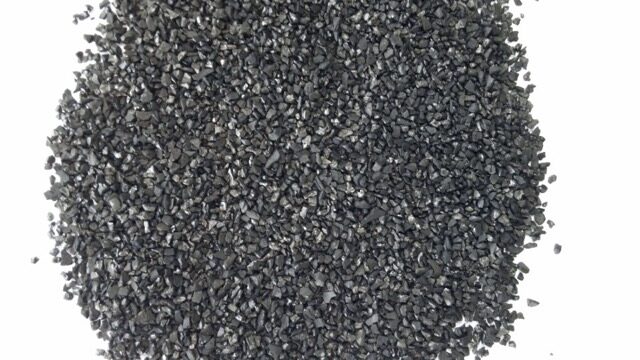Activated carbon, known for its excellent adsorption properties, is widely used in various industries such as water treatment, air purification, and metal refining. With continuous technological advancements, macroporous impregnated activated carbon, as a modified form of activated carbon, has gained increasing application due to its unique pore structure and enhanced adsorption capacity. This article will explore the basic principles, preparation processes, and key applications of macroporous impregnated activated carbon, and highlight the technological innovations and contributions of Hebei Huahuang Activated Carbon Co., Ltd. in this field.

Macroporous impregnated activated carbon is produced through an impregnation process in which specific chemicals are introduced into the pores of activated carbon to enhance its adsorption ability for certain substances. Activated carbon itself has a highly developed pore structure, enabling it to adsorb various harmful substances in water, air, and liquids. Impregnation treatment optimizes its pore size distribution and surface chemical properties, significantly improving its adsorption efficiency for particular applications.
Compared to standard activated carbon, macroporous impregnated activated carbon exhibits superior performance in certain fields, particularly in removing harmful gases, metal ions, and organic pollutants.
The preparation of macroporous impregnated activated carbon generally involves the following key steps:
Activation Process: Initially, the raw material for activated carbon (typically plant or animal-based carbon sources) is activated through physical or chemical methods. Physical activation usually involves high-temperature steam or carbon dioxide, while chemical activation uses substances such as zinc chloride or phosphoric acid to create activated carbon with high specific surface area and abundant pore structures.
Impregnation Treatment: After activation, the activated carbon is immersed in a solution containing specific chemicals. These chemicals can include metal salts (such as copper or iron salts) or organic molecules (such as acids or alkalis). The impregnation treatment alters the surface properties of the activated carbon, improving its ability to adsorb particular substances. For example, impregnating activated carbon with iron or copper salts can significantly enhance its ability to remove metal ions or organic pollutants.
Drying and Heat Treatment: After impregnation, the activated carbon is dried to remove solvents and then subjected to heat treatment at specific temperatures. This process helps to stabilize the impregnated components, enhancing the carbon's chemical stability and improving its long-term effectiveness.

Macroporous impregnated activated carbon, due to its significantly improved adsorption properties, has found widespread applications in the following fields:
Water Treatment
In water treatment, macroporous impregnated activated carbon is highly effective at removing harmful substances from water, such as heavy metal ions (e.g., lead, mercury), organic pollutants, pesticide residues, and disinfection by-products. The impregnation process enhances the carbon's adsorption ability, especially for removing certain pollutants like organic compounds and chlorides.
Air Purification
In air purification and industrial waste gas treatment, macroporous impregnated activated carbon is widely used to remove harmful gases from the air, such as nitrogen oxides, hydrogen sulfide, formaldehyde, and benzene compounds. Through impregnation, activated carbon develops stronger adsorption capacity for these gas molecules, significantly improving air purification efficiency.
Metal Refining
In metal refining processes, activated carbon is commonly used to adsorb impurities and gases produced during smelting, helping to purify metals. Macroporous impregnated activated carbon can improve the selective adsorption of metal impurities, thereby increasing the efficiency of metal purification.
Industrial Gas Treatment
In industries such as petrochemicals, metallurgy, and fertilizers, macroporous impregnated activated carbon is used to adsorb harmful components in waste gases, reducing environmental pollution. It plays an important role in handling high-concentration waste gases, removing volatile organic compounds (VOCs), and other toxic gases.
Pharmaceuticals and Food Industry
Activated carbon is also widely used in the pharmaceutical and food industries, particularly for detoxification and removal of impurities from certain drugs or food products. For example, activated carbon is used to remove colorants and impurities from food products, or to eliminate excess chemicals during drug production.
Since its establishment in 2004, Hebei Huahuang Activated Carbon Co., Ltd. has been dedicated to the research, development, production, and sales of activated carbon products. The company is a leader in the field of macroporous impregnated activated carbon, employing advanced production processes and innovative impregnation techniques to ensure the high performance of its products across various industries.
The company’s technical team continues to enhance the adsorption performance and application range of activated carbon by refining pore structure and surface modification technologies. Through this, Hebei Huahuang has developed customized solutions that meet the specific needs of water treatment, air purification, and industrial waste gas treatment. The company is also expanding into high-end fields such as environmental energy, new materials, and healthcare, driving innovation in activated carbon technology.
Macroporous impregnated activated carbon, as a modified material, offers significant advantages due to its unique pore structure and enhanced adsorption capabilities. It has demonstrated broad application prospects in environmental protection, industrial processes, and pharmaceuticals. Hebei Huahuang Activated Carbon Co., Ltd., through continuous technological innovation and product optimization, remains at the forefront of this field. As technology continues to progress, the application range of macroporous impregnated activated carbon will expand, providing more efficient solutions for environmental protection and industrial governance.
None of our operators are available at the moment. Please, try again later.